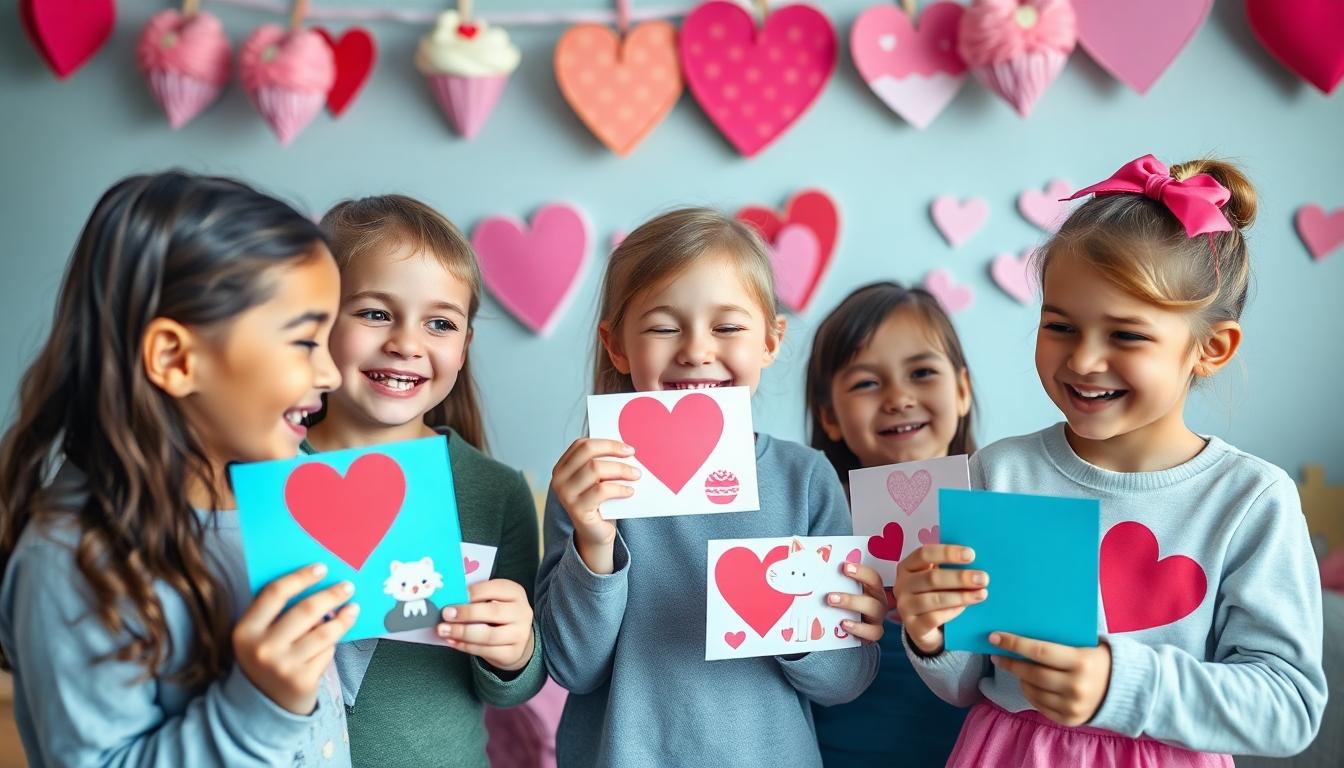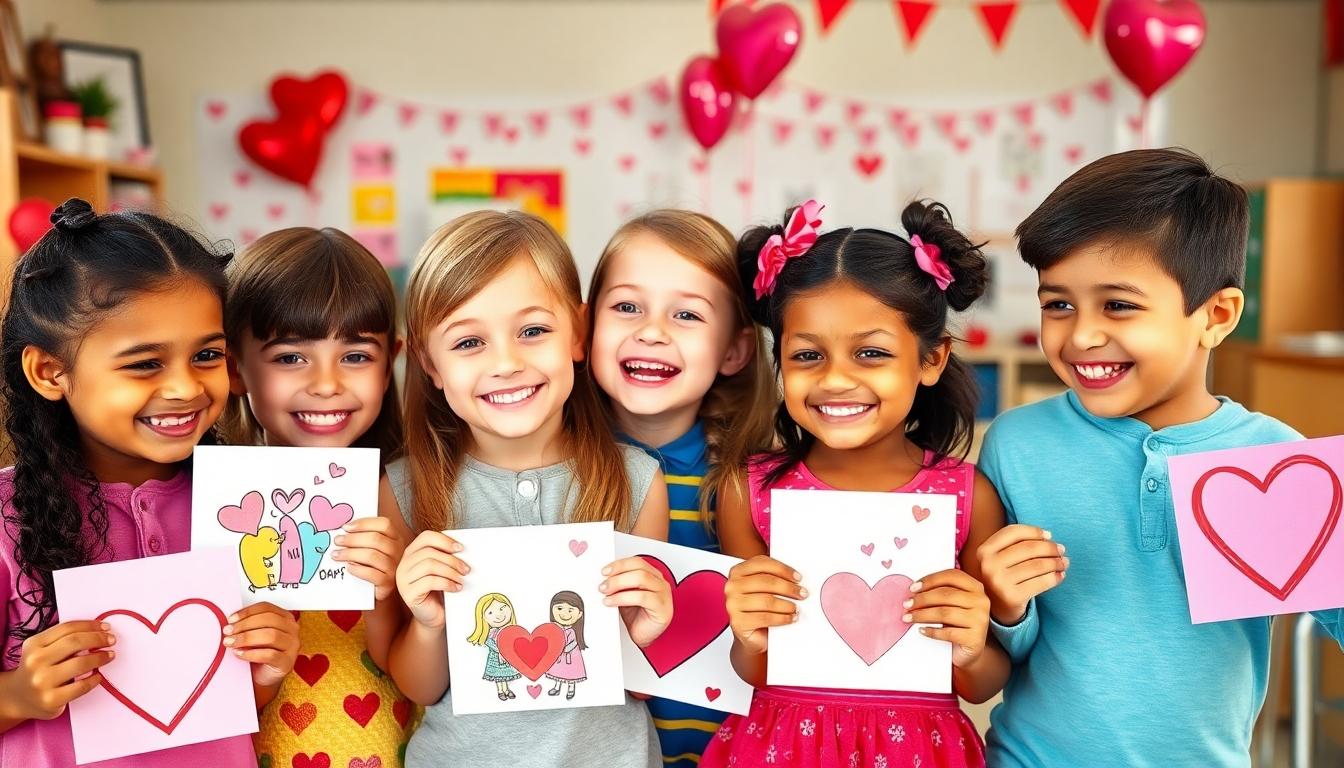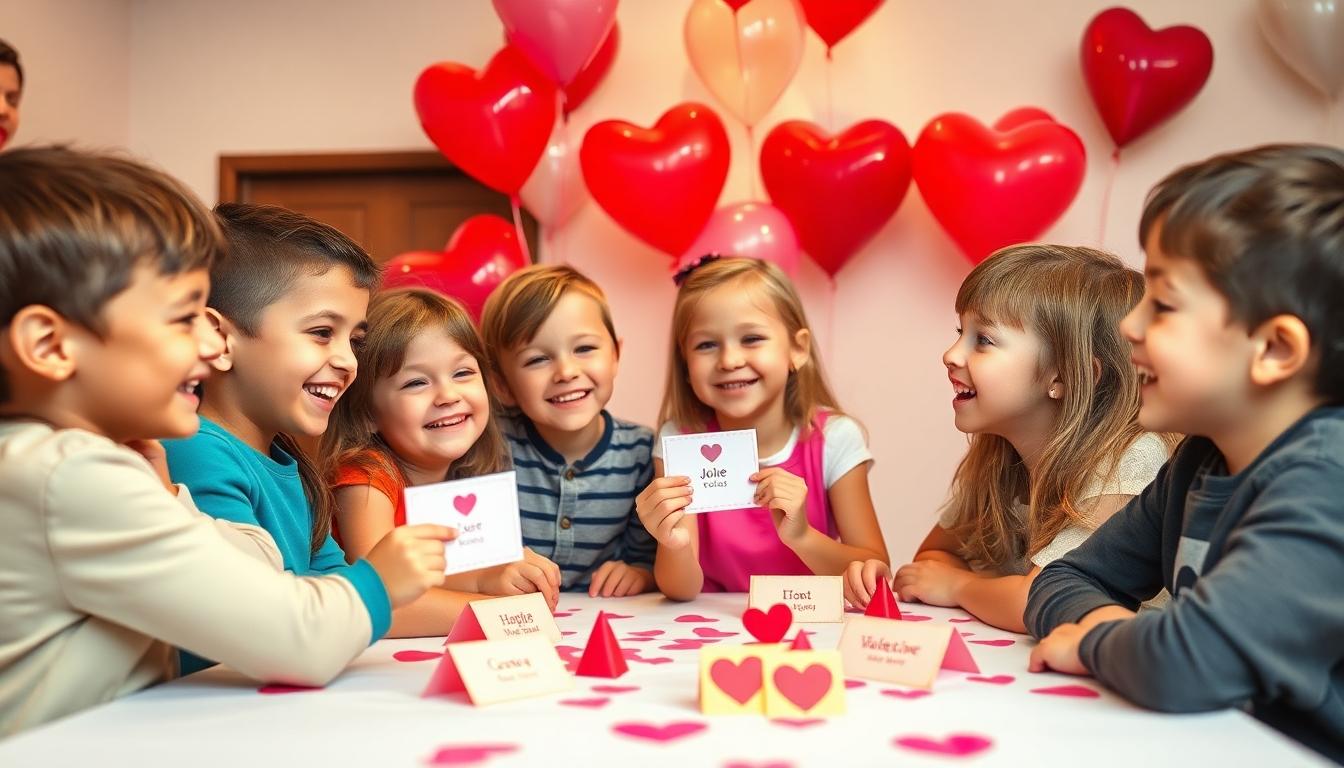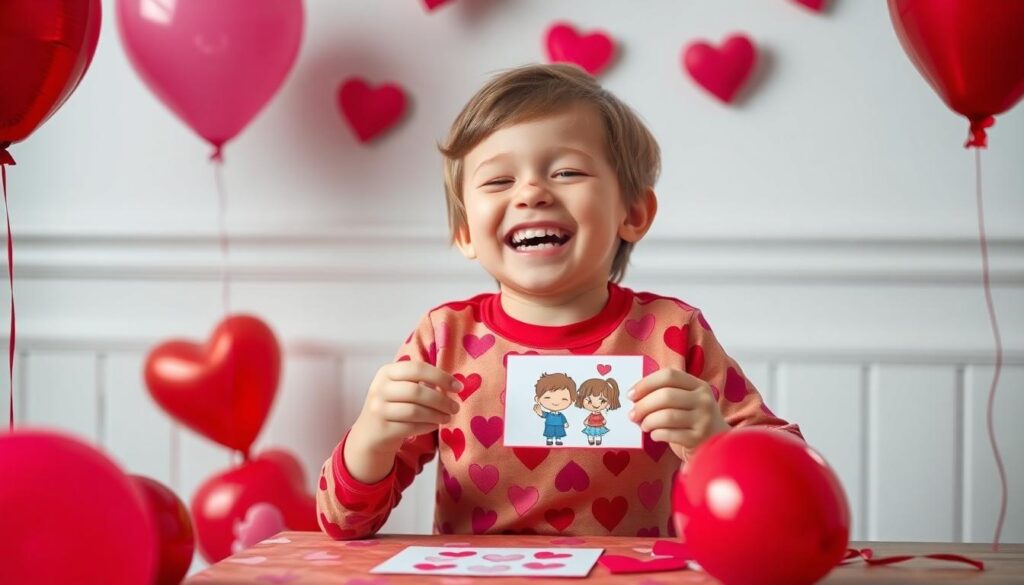Valentine’s Day isn’t just for grown-ups! We’ve collected the funniest, most adorable kid-friendly Valentine jokes that will have your little ones giggling while spreading the love. These clean, age-appropriate jokes are perfect for classroom exchanges, lunchbox notes, or simply brightening your child’s day.
Looking for ways to make February 14th extra special for the young ones in your life? These Valentine kid jokes deliver just the right amount of silly humor while celebrating friendship and love. From pun-filled one-liners to knock-knock jokes with heart-themed punchlines, we’ve got everything you need to bring smiles to those sweet faces.
10 Adorable Valentine Kid Jokes to Share with Your Little Cupids
- What did the paper clip say to the magnet on Valentine’s Day?
We find this one irresistible! The answer is “I’m so attracted to you!” Kids love this joke because it combines simple science concepts with Valentine’s humor, making it perfect for elementary school students.
- What did one volcano say to the other volcano?
Your little ones will erupt with giggles when they hear “I lava you!” This pun works wonderfully in classroom Valentine cards and never fails to bring smiles to young faces.
- How did the phone propose on Valentine’s Day?
Kids adore tech jokes, and this one delivers: “He gave her a ring!” This joke works perfectly for modern children who understand the dual meaning of “ring” in this context.
- What do you call a very small Valentine?
“A valentiny!” This adorable play on words is particularly popular with younger children who appreciate simple wordplay and can easily remember it to share with friends.
- Why didn’t the skeleton want to send Valentine’s cards?
Your child will love telling this one: “His heart wasn’t in it!” This silly anatomical joke appeals to kids who enjoy slightly edgy humor that still remains completely appropriate.
- What did the stamp say to the envelope on Valentine’s Day?
Stick this joke in your child’s lunchbox: “I’m stuck on you!” It’s a simple pun that even preschoolers can understand and retell accurately.
- What did the cat say on Valentine’s Day?
Meow-velous humor awaits with the answer: “You’re purr-fect for me!” Animal jokes consistently rank among children’s favorites, making this cat-themed valentine joke an instant hit.
- How can you tell that a calendar is popular?
Your kids will appreciate the timely humor: “It has many dates!” This joke works particularly well for older elementary students who understand the double meaning of “dates.”
- What did the boy octopus say to the girl octopus?
Get ready for tentacles of laughter with: “I want to hold your hand, hand, hand, hand, hand, hand, hand, hand!” Children love the silliness of this joke, especially when you count out all eight hands.
- What did one light bulb say to the other light bulb on Valentine’s Day?
Illuminate your child’s day with this bright joke: “You turn me on!” This clean joke works wonderfully for kids who might not catch any adult implications but understand the concept of turning on lights.
Why Valentine’s Day Humor Is Perfect for Children

Valentine’s Day humor offers more than just entertainment for kids—it provides valuable developmental benefits while making the holiday more enjoyable. Incorporating jokes into Valentine’s Day activities can significantly enhance children’s experiences in several important ways.
Building Social Skills Through Laughter
Humor serves as a powerful social development tool for children during Valentine’s Day celebrations. When kids share jokes with classmates, they naturally practice conversation skills and learn appropriate timing. Research shows that children who engage with humor develop better peer relationships as they create bonds through shared laughter experiences. Valentine jokes specifically encourage children to interact with others outside their immediate social circles, helping them build confidence in social situations. These lighthearted exchanges also teach kids how to recognize playful communication, an essential skill for developing healthy relationships throughout life.
Creating Positive Holiday Associations
Valentine’s Day jokes transform what might otherwise feel like a “grown-up” holiday into a fun celebration accessible to children of all ages. The playful nature of jokes like “How did the phone propose to his girlfriend? He gave her a ring!” creates joyful memories associated with the holiday. Many parents report that incorporating humor helps reduce any pressure children might feel about Valentine’s exchanges. These positive experiences with Valentine humor establish traditions children look forward to each year. Also, jokes such as “What did the farmer give his wife for Valentine’s Day? Hogs and kisses!” make the concept of expressing affection more approachable for kids who might otherwise find it uncomfortable or unfamiliar.
Sweet Valentine One-Liners Kids Will Love

Looking for quick Valentine’s jokes that will make kids giggle? These simple one-liners are perfect for Valentine’s cards, lunch notes, or just to bring smiles throughout the day.
“Knock Knock! Who’s there? Olive. Olive who? Olive you!”
“I love you s’more and s’more each day!”
“You’re the apple of my eye… and I’m just a little corny!”
“We go together like macaroni and cheese!”
Food-Themed Valentine Jokes
Food jokes are always a hit with kids during Valentine’s season, combining their love of treats with silly wordplay. These tasty puns will have children laughing while thinking about their favorite snacks.
“What did the blueberry say to the strawberry? I love you berry much!”
“What did the cucumber say to the pickle? You mean a great dill to me!”
“What kind of candy is never on time? Choco-LATE!”
“What did the honeydew say to the cantaloupe? You’re one in a melon!”
“What’s the most romantic utensil? A fork—it has Valen-tines!”
Animal-Inspired Valentine Giggles
Animal jokes add another layer of fun to Valentine’s Day celebrations, using cute creatures to deliver heartwarming punchlines. Kids love animals, making these jokes especially memorable for classroom exchanges.
“What did one owl say to the other? Owl be yours!”
“Why do birds fly south for Valentine’s Day? It’s tropical for love!”
Valentine Knock-Knock Jokes That’ll Have Kids Howling

Classic Valentine Knock-Knock Formats
Knock-knock jokes are a perfect addition to Valentine’s Day celebrations, offering simple setups with heartfelt punchlines kids will adore. These jokes follow a familiar pattern that even the youngest children can participate in and enjoy. Try these valentine knock-knock jokes with your little ones:
Knock knock!
Who’s there?
Luke
Luke who?
Luke who got a Valentine!
Knock knock!
Who’s there?
Peas
Peas who?
Peas be my Valentine!
Knock knock!
Who’s there?
Arthur
Arthur who?
Arthur any more Valentine cards for me?
The beauty of these jokes lies in their predictable format combined with unexpected twists. Children love the anticipation of waiting for the punchline and the satisfaction of connecting the character’s name to a Valentine’s Day message.
Interactive Joke-Telling Tips
Getting the most laughs from Valentine knock-knock jokes requires a bit of theatrical delivery. We recommend encouraging kids to ask “Who’s there?” in dramatic voices, making the joke-telling experience more captivating. Building anticipation works wonders for maximizing laughter—try pausing dramatically before delivering the punchline to create suspense.
Turn joke-telling into a creative activity by inviting children to invent their own knock-knock characters and Valentine punchlines. This activity stimulates their imagination while keeping the Valentine’s Day spirit alive. Kids can incorporate favorite characters, foods, or even classroom items into their original jokes.
For group settings, form a joke circle where each child contributes one part of a knock-knock joke, creating a collaborative comedy experience that builds classroom community. Jokes can also become Valentine’s Day card content, combining humor with heartfelt messages for classmates and family members.
Punny Valentine Jokes for Elementary School Students

Valentine’s Day jokes for kids thrive on wordplay and simple humor that elementary students can easily understand and appreciate. These puns incorporate everyday objects, foods, and holiday themes that bring smiles to young faces.
Word Play for Young Valentines
Elementary-friendly jokes focus on easy-to-understand puns that connect with younger audiences. Rhyming jokes like “What’s a small valentine called? A valen-tiny!” are perfect for kids who are just learning to appreciate wordplay. Double meaning puns add another layer of fun, with examples such as “How can you tell if a calendar is popular? It has lots of dates!” Animal-themed humor also resonates well with children, especially jokes like “What did the elephant say? I love you a ton!” Object-based humor works wonderfully too, with punchlines such as “What did the doorknob write? I a-door you!” These simple yet clever jokes align perfectly with elementary students’ developing sense of humor.
Jokes Perfect for Valentine Cards
Short, card-ready jokes make Valentine exchanges extra special for school children. Kids love seeing “Olive you!” in a knock-knock joke format on their cards. Food puns like “You’re my butter half!” pair wonderfully with cute illustrations on handmade valentines. Biblical humor works surprisingly well with statements such as “Did Adam and Eve have a date? No – they had an apple!” Insect-themed jokes add whimsy to any valentine with lines like “Why are insects good daters? They’re lovebugs!” Book-loving children appreciate literary puns such as “What’s a heart’s favorite book? A well-red one!” Time-sensitive jokes including “Why do skunks celebrate? They’re scent-imental!” and “How did the coin propose? With a jingle!” create memorable moments during classroom exchanges. Calendar humor directly connects to the holiday with jokes like “Who always has a date? A calendar!” These brief, auditory punchlines fit perfectly with elementary students’ vocabularies and humor preferences.
Valentine Riddles to Challenge Young Minds

Valentine’s Day presents the perfect opportunity to engage children with fun brainteasers that combine love themes with clever wordplay. These riddles not only entertain but also encourage critical thinking in young minds.
Heart-Themed Brain Teasers
Kids will love solving these Valentine-themed riddles that play with words and concepts related to hearts and love. “What shade of red is your heart?” The answer is “beat red!” – a playful twist that combines anatomy with color. For a giggle-worthy exchange, ask “What do you call the industry’s smallest Valentine’s Day card?” The answer, “a valen-teeny,” combines miniature size with the holiday name. Children will also enjoy asking “What did one plate say to the other on Valentine’s Day?” with the clever response “Tonight, dinner’s on me.” Farm-loving kids might appreciate “What did the farmer give his wife for Valentine’s Day?” – “Hogs and kisses,” a country-themed spin on the classic expression.
Love-Inspired “What Am I?” Riddles
These captivating guessing games challenge children to think creatively about Valentine’s concepts. Try asking “I’m sticky and sent with a letter. What am I?” The answer is a stamp with the implied message “I’m stuck on you!” Nature enthusiasts will enjoy “I’m hot, explosive, and say ‘I lava you!’ What am I?” – a volcano, of course! For young animal lovers, “I buzz around flowers and say, ‘You make my heart buzz!’ What am I?” makes for a sweet bee-themed riddle. Fruit-based wordplay works wonderfully too, with “I’m a fruit that says, ‘You’re one in a melon!’ What am I?” The answer – a watermelon – combines food fun with Valentine sentiment. These “What am I?” formats encourage children to connect descriptive clues with everyday objects in a Valentine context.
Using Valentine Kid Jokes in Classroom Activities

Incorporating Valentine kid jokes into classroom activities creates a lively atmosphere while promoting learning through humor. These joke-based activities can transform ordinary Valentine’s Day celebrations into memorable educational experiences.
Joke-Based Valentine Games
Valentine’s Day joke games offer excellent opportunities for student engagement and social interaction. The “Valentine’s Day Joke Challenge” encourages students to share their favorite Valentine’s jokes with classmates before voting on the most amusing one, building confidence and public speaking skills. “Guess the Punchline” adds an interactive element where teachers read the setup of a Valentine’s Day joke and students compete to predict the punchline, developing listening skills and creative thinking.
Creating “Valentine Joke Bookmarks” gives students a practical item they can use during reading time while spreading laughter throughout the day. These bookmarks serve as perfect morning meeting icebreakers that set a positive tone for the day’s learning activities. Implementing a “Joke of the Day” countdown leading up to February 14th builds anticipation while providing daily opportunities for classroom bonding over shared humor.
“Valentine’s Day Joke Puzzles” combine problem-solving with humor by breaking jokes into parts that students must reassemble correctly. This activity strengthens reading comprehension while adding a fun challenge to Valentine parties.
Educational Benefits of Humor
Valentine jokes deliver important educational value beyond just entertainment. Using humor in the classroom builds a stronger classroom community by fostering shared laughter experiences that connect students through positive emotions. Jokes improve student focus by providing brief mental breaks that actually enhance attention spans during subsequent learning activities.
Creative thinking flourishes when students engage with Valentine jokes, as humor requires making unexpected connections between ideas. Many students feel inspired to create their own Valentine jokes after hearing examples, developing important language skills through wordplay and pun creation. The emotional connection formed through humor helps students retain information more effectively than traditional learning methods.
Sharing Valentine jokes also develops crucial social skills as children practice appropriate timing, delivery, and audience awareness. For shy students, joke-telling offers a structured way to participate in classroom discussions with predetermined content that reduces social anxiety. The confidence gained through successfully sharing jokes often transfers to other areas of academic performance and classroom participation.
Valentine Jokes That Teach While They Entertain

Valentine’s Day humor doesn’t just bring laughter—it can also reinforce educational concepts in a fun, memorable way. These jokes combine holiday themes with learning opportunities, making them perfect for classroom use or educational moments at home.
Science-Related Valentine Humor
Science concepts become much more captivating when wrapped in Valentine’s Day fun. Kids can learn basic scientific ideas while giggling over these clever jokes:
- Chemistry connection: What did one atom say to the attractive atom? “I’ve got my ion you!”
- Oceanic affection: What did one boat say to the other? “Are you up for a little row-mance?”
- Tentacle talk: What did the boy octopus say to the girl octopus on Valentine’s Day? “I want to hold your hand, hand, hand, hand, hand, hand, hand, hand!”
- Heart facts: Why was the heart looking red? Because it was “beat red” all day long!
- Animal biology: How do dolphins show their Valentine’s love? They give each other lots of porpoise hugs!
Math and Word Play Valentine Jokes
These jokes combine number concepts and wordplay, helping children develop language skills and basic math understanding:
- Calendar counting: How can you tell if a calendar is popular? It has a lot of dates!
- Mathematical affection: What did the calculator say to the pencil? “You can count on me!”
- Fraction fun: What did the paper say to the pencil? “I’m drawn to you!”
- Measurement matters: Why did the ruler fall in love with the pencil? Because they were the perfect match!
- Avian wordplay: What do you call two birds in love? Tweet-hearts!
- Size comparisons: What do you call a very small valentine? A valen-tiny!
- Pattern recognition: What did the stamp say to the envelope on Valentine’s Day? “I’m stuck on you!”
How to Create Your Own Valentine Kid Jokes

Creating original Valentine’s Day jokes for kids isn’t just fun—it’s a wonderful way to connect with children through humor that speaks directly to them. Let’s explore how you can create jokes that’ll have your little ones giggling.
Following Kid-Friendly Joke Patterns
Valentine jokes for children work best when they follow established patterns that kids naturally understand and enjoy. Puns and wordplay make excellent foundations, especially when tied to holiday themes like hearts and love. Research shows that effective kid jokes often use rhymes and soundalikes, such as telling someone they’re a “great dill” (with a pickle drawing) or saying “I dig you” alongside a gardening image. Visual puns are particularly effective with younger children—jokes about a “valen-teeny” card or sending “hogs and kisses” (with pig pictures) create instant laughs.
Pop culture references work wonderfully for older kids who’ll appreciate jokes like “Cupid’s favorite band is Kiss” or song-inspired puns. Animal themes consistently rank among children’s favorites, with classics like “I love ewe” (with a sheep) or “You’re purr-fect” (with a cat) making reliable templates you can adapt. For the best results, structure your jokes in simple question-answer format or use familiar setups that children can easily follow and eventually predict.
Personalizing Jokes for Your Child
Making Valentine jokes truly special means tailoring them to your child’s exact interests and personality. Incorporate their hobbies into your wordplay—for a soccer-loving child, try “Why did the soccer ball fall in love? It was head over heels!” For a dinosaur enthusiast, “You’re dino-mite!” works perfectly.
Add their name directly into jokes for an extra personal touch that shows you made it just for them—”Riley, you’re one in a melon!” feels much more special than a generic version. Always consider your child’s age when crafting jokes, as younger kids typically prefer straightforward humor with obvious punchlines (“Why did the cookie blush? It saw the sweetheart!”), while older children appreciate more sophisticated wordplay like “You’re acute” alongside a triangle drawing.
Daily objects from your home environment make excellent joke material because they’re instantly recognizable to your child. A joke about a plate saying “dinner’s on me” or a paper clip finding a magnet “attractive” connects humor to their everyday industry. Remember that the most memorable Valentine jokes combine simple setups with visual elements and holiday themes that resonate with your child’s unique perspective.
When and How to Share Valentine Kid Jokes

Valentine jokes aren’t just funny—they’re incredibly versatile when it comes to brightening up February 14th celebrations. These kid-friendly jokes can be incorporated into various settings to create memorable moments and foster a festive atmosphere.
Valentine’s Day Party Ice Breakers
Starting your Valentine’s Day party with humorous jokes creates an instant welcoming atmosphere for young guests. We recommend using these jokes during the initial gathering phase when children are still warming up to each other. Place joke cards at each seat or create a joke station where kids can pick up a joke to share with someone they don’t know yet. Games like “Valentine Joke Musical Chairs” work wonderfully—when the music stops, each child reads the joke on their chair to the group. These light-hearted ice breakers effectively dissolve any social anxiety that might exist at the beginning of the party. Joke-telling contests can also encourage participation from even the shyest children, giving everyone a chance to shine and laugh together.
Family Dinner Table Joke Sessions
Transform your Valentine’s Day family dinner into an entertaining experience by incorporating joke-telling traditions. We suggest creating special Valentine-themed place cards with jokes written inside them, providing each family member with their own joke to share. Taking turns telling Valentine jokes between courses keeps the conversation flowing and creates a joyful mealtime environment. Parents can initiate the fun by starting with classics like “What did one volcano say to the other? I lava you!” Children typically love participating in these sessions, often giggling before they even finish telling their jokes. Family joke sessions establish positive holiday associations and create traditions that children look forward to year after year. These moments of shared laughter strengthen family bonds, making ordinary dinners extraordinary through the simple addition of Valentine humor.
The Lasting Benefits of Sharing Valentine Kid Jokes with Children
Valentine kid jokes offer so much more than just momentary giggles. They create lasting memories while developing crucial social and cognitive skills in children. By sharing these punny one-liners and silly riddles we’re helping kids build confidence communication abilities and positive holiday associations.
Whether tucked into lunchboxes written on classroom valentines or shared during family celebrations these jokes transform February 14th from just another holiday into a meaningful bonding experience. The laughter they inspire connects children with peers parents and teachers alike.
We hope these jokes bring joy to your Valentine’s Day celebrations! Remember the best gift we can give children isn’t just candy or cards—it’s the priceless sound of their laughter and the warm feeling of being included in the fun.
Frequently Asked Questions
Why are Valentine’s jokes good for kids?
Valentine’s jokes help children develop social skills, boost confidence, and create positive associations with the holiday. They transform Valentine’s Day into a fun celebration rather than a pressure-filled event. These jokes encourage conversation practice, critical thinking, and creativity while building classroom community and family bonds through shared laughter.
What types of Valentine’s jokes do kids enjoy most?
Kids especially enjoy puns, wordplay, and jokes that relate to their interests. Food-themed jokes (“I love you berry much!”), animal jokes (“Owl be yours!”), and simple science puns (“I’m so attracted to you!”) are particularly popular. Short, silly one-liners work well for younger children, while elementary students appreciate the clever wordplay of riddles and puns.
How can I use Valentine’s jokes in a classroom setting?
Incorporate jokes into classroom activities through games like “Valentine’s Day Joke Challenge” or “Guess the Punchline.” Create joke bookmarks, implement a daily joke countdown, or use humor to reinforce educational concepts. These activities promote student engagement, social interaction, and a positive learning environment while making Valentine’s Day memorable.
Can Valentine’s jokes support learning?
Absolutely! Valentine’s jokes can reinforce educational concepts in an engaging way. Science-related jokes like “What did one atom say to the attractive atom? I’ve got my ion you!” make learning fun, while math jokes help develop language skills and basic math understanding. The critical thinking required to understand riddles strengthens cognitive development.
How can I create my own Valentine’s jokes for kids?
Create personalized jokes by following established patterns, using puns related to Valentine’s themes, and incorporating your child’s interests. Keep setups simple and use familiar objects to make jokes relatable. Connect wordplay to holiday themes like hearts, friendship, and love while ensuring the humor is age-appropriate and clean.
Where should I share Valentine’s jokes with children?
Share jokes on Valentine’s cards, lunchbox notes, and classroom exchanges. Use them as ice breakers at parties or during family meals. Create joke stations or place cards featuring jokes to encourage participation. These simple gestures spread joy throughout Valentine’s Day celebrations and help children develop positive associations with the holiday.







